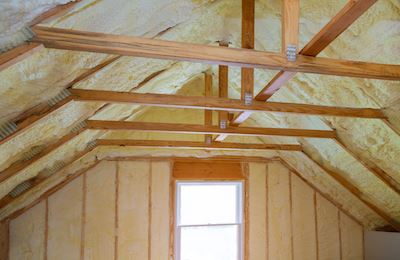When you pop your head up into your attic, you’ve probably noticed the insulation tucked in between the boards. If it’s doing a proper job, your insulation is helping to keep your conditioned air where it’s supposed to be. It prevents heated or cooled air from escaping from the conditioned rooms in your home, and out through the roof and walls of your house. 
In general, there are two types of insulation: fiberglass and cellulose. Fiberglass is made from sand and glass, with up to 20 percent made from recycled glass. Cellulose is made mostly from recycled materials, including paper. And since both products make your home more energy efficient, that’s a win for the environment no matter which product you choose.
But if you’ve ever done a little investigating to learn more about both types of insulation, you may have discovered a few worrisome facts. Should you really have either of these products in your home? Do the hazards outweigh the risks? Are they both safe products to help improve the efficiencies of your home? Let’s talk about the potential hazards.
Moisture
Moisture can be the number one enemy to both types of insulation. And the way both types of insulation are packed and used in your home, they can both retain a significant amount of moisture before you notice the problem. That’s why it’s important to keep an eye on places like your attic where sudden leaks can occur.
Of course, in perfect conditions, your attic stays warm and dry. But a lot of things – age, damage, rot, etc – change over the course of time, and may impact the safety of your home. As moisture or humidity settle in, it saturates the area around it. And the more moisture sits and continues to build, the bigger mess you’ll have. It may even allow biological growth to appear.
Both fiberglass and cellulose are susceptible to moisture. A study found that cellulose actually is impacted less by moisture than its fiberglass counterpart. Bottom line: the best protection is to avoid moisture altogether.
Touch
Fiberglass. Just the thought has you reaching out and itching your skin. We’ve all heard the horror stories of what this pink material can do to your skin. When it comes in contact with it, those little pieces of spun glass can quickly become embedded in your skin.
It may not cut you, but it can make you itch for several days.
The best way to protect yourself is to cover your skin before you work with fiberglass. Wear pants and long sleeves if you enter your attic. Wear gloves if you touch it. A little protection goes a long way.
Breathe
Of course, the biggest hazard most people think about is breathing in fiberglass to the lungs. A lot of talk occurred a decade or two ago about the risks of fiberglass. Turns out, they may have been wrong.
Studies now show that while taking in fiberglass materials into your lungs is never a good thing, the most it will do is leave you coughing, sneezing, or wheezing for a bit. Once the tiny particles pass, the risk is gone. The National Academy of Sciences feels that fiberglass does not cause cancer.
Of course, that doesn’t mean you should be careless around it. It can still impact your health in a big way. If you aren’t properly trained or understand the nuances of working with fiberglass material, it’s best left to the professionals.
And cellulose also has its own problems. The National Institute for Occupational Safety has determined that the dry dust from cellulose insulation can be hazardous. Installers are advised to wear appropriate protection, including a respirator when working with it.
But overall, these hazards don’t apply to you, the homeowner. Why?
Because insulation isn’t in your living space. You won’t come into daily contact with it. You won’t be installing it. And if you do go up into your attic or crawlspace, don’t disturb it. Just leave it alone, and you’ll be fine.
When’s the last time you checked on how well your insulation was performing?

